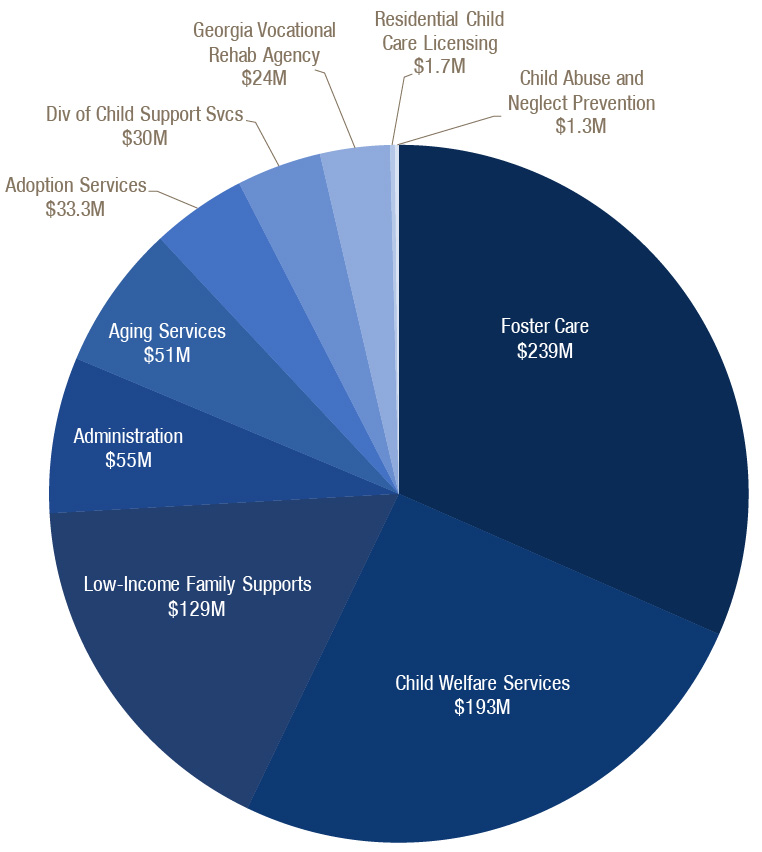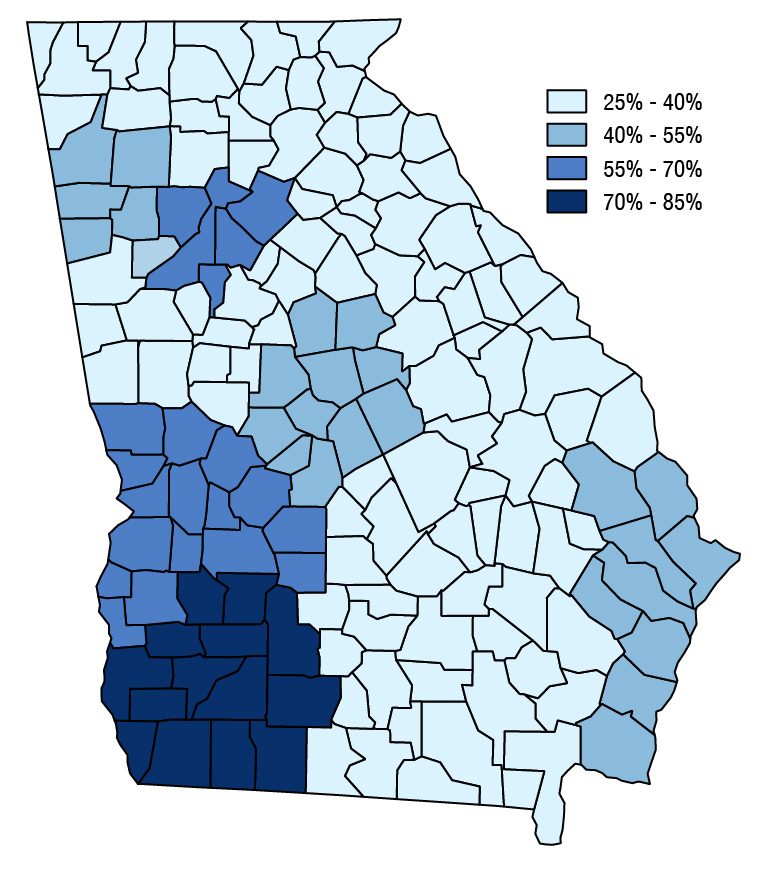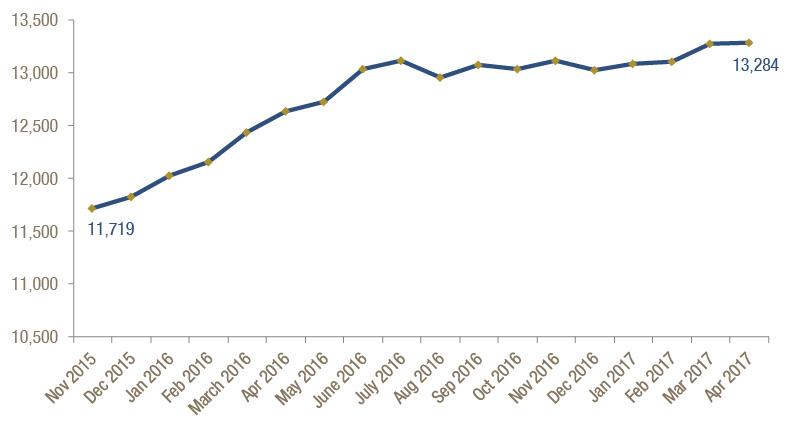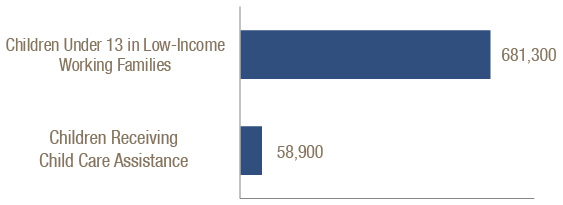Human Services Budget Overview
Georgia’s Department of Human Services oversees state spending to protect children and seniors, as well as provide non-medical assistance to people with low incomes. The agency’s state funding is $757 million in 2018, or 3 percent of state spending.
Child welfare-related services represent the largest share of the department’s responsibilities, accounting for $467 million, or 62 percent, of its 2018 budget. These services include protecting children from abuse, abandonment and neglect, as well as safeguarding them in suitable temporary and permanent homes.
About $129 million of the Human Services budget helps low-income families gain access to Temporary Assistance for Needy Families, nutrition assistance, Medicaid and other federal services. These services help children stay healthy and keep adults prepared for job opportunities, putting them on a path to financial independence.
Other department functions protect and sustain older Georgians, enforce parents’ responsibility to financially support their children and help people with disabilities get jobs. The department’s employees also license, monitor and inspect temporary foster homes.
Georgia’s Children Major Focus of Human Services

Child Welfare: Workers Receive Needed Investment
The Child Welfare portion of the Human Services budget, $193 million, pays the salaries of workers who investigate allegations of child abuse, abandonment and neglect.
Lawmakers added about $26 million to the department’s budget in 2018 to boost salaries for child welfare case managers and their supervisors by 19 percent on average. The governor’s 2015 Child Welfare Reform Council report recommended pay increases for case managers.
Low salaries are a big cause of frequent staff turnover. The turnover rate for Georgia child welfare workers stands at 29 percent.
Reducing turnover among child welfare case managers helps reduce caseloads for each worker. Each child welfare case manager handled anywhere from 20 to 31 cases at once in 2016, with variation by region. Child welfare experts indicate caseloads should be about 10 to 15 cases per worker. The Division of Family and Children’s services projects caseloads to range from eight to 19 per worker with improved case manager retention.
Reducing Turnover Projected to Reduce Caseloads for Child Welfare Workers
Projected Average Caseload Reduction if All Positions Filled

*Note: Centralized intake call center staff are housed in Region 10. These workers do not carry a caseload, making a decrease appear artificially high
Foster Care Gets Boost as Child Abuse Reports Rise
Foster families, child placement agencies and child care institutions, or group homes, are set to receive additional money to help meet the needs of Georgia’s children. Georgia’s 2018 budget adds $20 million to keep pace with growth in foster care. Increased reports of child abuse contributed to a 13 percent uptick in the number of children placed in foster care since November 2015.
The 2018 budget adds nearly $11 million to increase monthly payments for child care costs to about a quarter of Georgia’s foster families. The foster families projected to receive the increase are recruited and managed by the Division of Family and Children’s Services, as opposed to private agencies.
Foster families recruited and managed by private agencies are scheduled to receive a similar increase over two years. Georgia’s 2018 budget adds $5 million to increase payments to these foster families. The spending plan also adds nearly $15 million to increase monthly payments to relatives caring for children in foster care.
In 2017, the state reimbursed a family that cared for a foster child $15 to $20 per day, depending on the age of the child and the type of placement. This is designed to cover food, shelter, clothing, basic supervision and oversight.
Foster Care Placements Up 12 Percent Over 1.5 Years

New Integrated Eligibility System Increases Efficiency, Reduces Fraud Risk
Georgia’s 2018 spending plan adds $11 million to complete implementation of an Integrated Eligibility System – Georgia Gateway. Georgia Gateway is the largest information technology project in the state’s history. The system is designed to serve as a one-stop shop to help Georgians to determine eligibility for six of the state’s major benefit programs:
- Medical Assistance, including PeachCare for Kids
- Supplemental Nutrition Assistance Program
- Temporary Assistance for Needy Families
- Women, Infants, and Children Supplemental Nutrition Program
- Childcare and Parent Services Program
- Low Income Home Energy Assistance Program
Georgia Gateway replaces outdated systems used to determine eligibility. The new system is designed to offer timely and more accurate delivery of assistance for residents across programs. The department received federal scrutiny over delays in processing benefits from 2014 to 2016. Federal officials warned Georgia it faced $76 million in penalties for the delays until lifting the threat in December 2016.
The new integrated system is also designed to reduce the risk of fraud, increase efficiency and lessen manual work. Federal funding covers the bulk of the Georgia Gateway system.
A pilot of the new system is now taking place for every program except energy assistance in the state’s counties other than DeKalb, Gwinnett and Fulton. The department plans to phase in these three counties September 2017.
State Adds Money for Quality Child Care, Substantial Needs Remain
Georgia’s Department of Early Care and Learning provides access to quality child care and early learning for families that earn low incomes. Parents who receive child care assistance generally experience fewer work disruptions, stay employed longer and enjoy higher family earnings.
The high cost of child care can be a huge financial obstacle for parents who want to work. The average annual cost of center-based child care for an infant in Georgia is $7,597. The average cost is $4,451 for a school-aged child. These costs can easily consume from one quarter to more than half of a low-income family’s budget.
Georgia’s 2018 budget adds $5.5 million for the state’s child care subsidy program – the first new state money for child care assistance in at least 10 years. The money should provide an incentive to providers in the subsidy program to increase the quality of care they offer. This helps parents focus on work without worrying while their children receive quality early learning that better prepares them for school.
This new investment is an encouraging development, but additional resources are needed to ensure more parents can access quality child care.
Georgia Child Care Assistance Helps a Fraction of Those in Need









